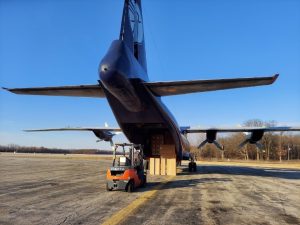Air Freight vs Ocean Freight – Which is right for you?
When shipping goods globally, there are two modes of transportation to choose from – sea and air. Which is the best option for your cargo? There are several important factors to consider. However, if timeliness is on the top of your list, the most obvious choice is air freight since it’s the fastest.
Ocean Freight
Besides speed, there are other aspects that differ between ocean freight (aka sea freight) and air freight. Ocean freight is generally considered to be ideal for transporting large quantities of cargo. Much of this is due to the large space available on ship decks and cargo holds, making maneuvering large containers filled with goods to be shipped a bit easier.
Also, the average cargo ship can carry between 15,000 – 18,000 cargo containers onboard. This enormous cargo capacity makes shipping by sea typically more economic.
Transportation of Hazardous Materials (HAZMAT), such as compressed gases, flammable materials, and toxic or corrosive materials, are restricted by air freight. These items can be shipped by sea, however, under the International Maritime Dangerous Goods Code (IMDG Code).
Types of Ocean Freight
The main categories for cargo that is shipped by sea are Roll-On/Roll-Off (RORO), Break Bulk, Dry Bulk, Liquid Bulk, and Container Cargo.
RORO refers to items such as automobiles, heavy machinery and other vehicles that are transported overseas. Cars, etc. are driven onto the cargo ship and securely parked. Upon arrival at its destination, the vehicles are driven off the ship.
Break bulk cargo consists of items transported in bags, boxes, crates, drums or barrels – or items that are too large to fit inside a standard container. Break bulk cargo is loaded onto the ship individually and counted as separate units.
Dry bulk includes goods such as grain, iron ore, cement, salt, sugar and sand. These items are transported as loose cargo in the ship’s holds.
Liquid bulk encompasses cargo such as petrol, fuel oil, vegetable oils, chemicals like polymer additives, liquefied natural gas (LNG), and more. Large volumes of these liquids are shipped in tanks on cargo ships furnished with the necessary equipment to properly load and unload the tanks safely.
Container cargo refers to consumer goods such as clothing, electronics, toys, home décor, etc. Items such as these travel inside a shipping container called an intermodal container. This type of container allows the cargo to go from ship to rail or truck without having to unload and reload the cargo.
Disadvantages of Ocean Freight
As mentioned earlier, one of the main drawbacks of transporting goods by sea is the length of time it takes to get from one destination to another. It can take weeks, even months for ocean freight to arrive.
Weather is a major factor for ocean freight, as rough seas can slow a ship’s speed down considerably, leading to even longer wait times. Port congestion, labor issues at ports, and incorrect customs paperwork can all cause further delays.
Along with slowing a ship down, bad weather can result in cargo damage, or even loss. High waves can cause goods to be tossed and toppled inside their shipping containers if not packed properly. Even worse, entire shipping containers can break loose and end up in the ocean.
Shipping by sea is also less convenient, as routes and timetables are usually inflexible. Additionally, tracking the progress of goods is very difficult.
Air Freight
Moving freight by airplane is clearly a faster option when compared to sea. Though airplanes carry less volume in a single trip, goods shipped via air will arrive at their destination within days, possibly hours, rather than weeks or months. Thus, air freight is ideal for shipping high value goods, those that have a limited shelf life or parts that are vital in the manufacturing of another item.
There are two ways in which to ship freight by air. One would be in the belly of a regularly scheduled passenger plane run by a commercial airline. The other option is by charter flight. When contracting a charter plane to fly your freight, you determine the departure time and destination.
Due to high security levels at airports and tightly managed safety controls, shipping via air is considered to be more secure then shipping by sea. Customs clearance and cargo inspection are also more efficient at airports, thus less warehouse time for air goods, which saves money.
Types of Air Freight
Cargo being transported by air are categorized under two main groups: general and special. General cargo are items that do not require special handling or extra precautions during air transport. This includes most consumer goods, dry goods, hardware, textiles, and more.
Special cargo has specific requirements for transport, such as temperature and humidity-controlled containers, extra packaging, additional labelling, etc. Examples of special cargo include livestock, perishable items, medications and certain chemicals.
Delays in Air Freight
While transporting goods by air is overall faster, delays may happen on occasion. Most delays are due to issues involving the trucks that are transporting goods from the warehouse to the airport. Heavy traffic can cause delays, as can incomplete or incorrect documentation.
Weather conditions can also be the source of a delay. However, flights are usually able to be rearranged and rescheduled quickly and efficiently.
Shipping Your Air Freight
If you’ve decided that air freight is the right transportation method for you, Grand Aire is here to help. We have been operating as a leading air service provider for over 35 years.
Our Logistics Specialists are accessible 24/7/365 to provide you with the most favorable air transportation options available. Simply call 1-800-74-GRAND or email our team at logistics@grandaire.com.
